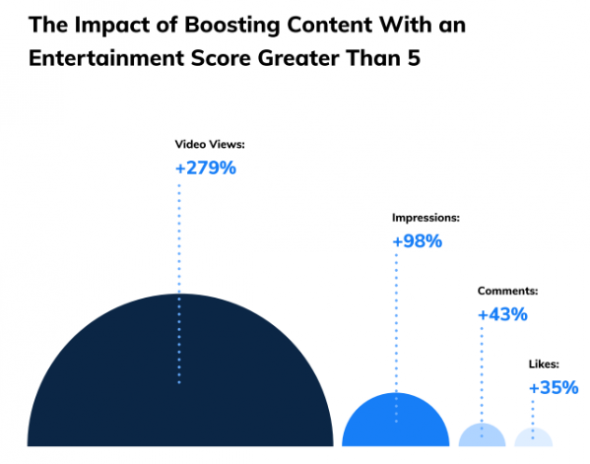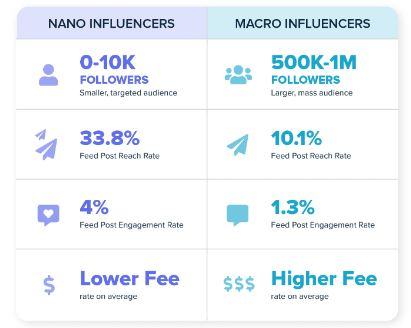In this article, we explore the evolving social media landscape, discover what musicians can learn from brands, and speak with music influencer Agustina Arcolia to understand how to make content people want to watch.
Six social-media truths in 2024
- Viewers want to be entertained and storytelling generates better business outcomes
- Short-form video delivers the highest ROI of any content format (HubSpot’s 2024 State of Marketing Report)
- Authentic user-generated content outperforms studio-filmed brand content (Meta)
- Not all channels deliver the same outcome. TikkTok has the highest engagement rate at 5.54% (Dash Hudson)
- 57% of consumers report feeling a connection with a brand would motivate them to spend more money (SemRush)
- Trends and Trending content are not the same. Long-term trends allow you to align with a community to build loyalty, engagement and legacy. Short-term trending content can offer quick wins if it aligns with your overall image
To optimise social media content in 2024 these six truths need to be embedded in a holistic content strategy that recognises the shift towards social commerce.
The importance of a holistic content strategy
Now more than ever, organic, paid and influencer marketing content have distinct roles within a content marketing strategy. An effective social media strategy must support three objectives.
- Maintain a community of loyal fans (organic)
- Grow brand awareness among a targeted community (paid)
- Engage niche subcultures (influencers)
Organic content.
Organic content created and shared by you on your profile provides a regular drumbeat of fresh content to maintain communication with loyal fans. It also helps you understand which content resonates with your audience and which content to support and boost with paid content.
Paid content
Paid or boosted content allows you to get your highest-performing content in front of highly targeted audiences. Paid content delivers significantly more impressions than influencer or organic content, highlighting its key role in building brand awareness.

Source Dash Hudson. The Next Phrase of Creator, Organic & Paid
Paying to boost a piece of content breaks it out of a platform’s algorithm and places it in the feeds of targeted users who might not otherwise discover you. As a result, this approach excels at growing brand awareness among a select audience of potential fans.
While boosting succeeds in increasing visibility, these efforts don’t typically translate into higher levels of engagement. Research from Dash Hudson found after boosting organic content, the engagement rate decreased by an average of 28% from 3.5% to 1.9%,
Entertaining content performs even better when boosted.
However, producing entertaining content is challenging. Research by Dash Hudson found only 16% of the content boosted by brands had an Entertainment Score of 5 and above. Brands just like musicians often fall into the trap of making content about them, pushing products, services and offers at consumers, rather than pulling them in with entertaining content first.
Influencer content.
Watch the full interview with music influencer and full-time content creator Augustina Arcolia (above) and learn how to create content people stick around to watch.
The influencer marketing industry grew to $21.1 billion in 2023 up from $16.4 billion in 2022. (Internet Marketing Hub) Gen Zers trust influencers the most, 33% of them report buying a product based on an influencer’s recommendations.

Source Fohr Later.
Using influencers helps you reach niche audiences through existing communities generating more engagement than paid or organic content. Successful influencer marketing is no longer reliant on a Kylie Jenner endorsement. Research shows that micro-influencers typically have higher engagement rates than their celebrity counterparts and consumers perceive them as more authentic.
However, using an influencer for one-off posts is unlikely to deliver long-term results. Savvy marketers are now looking to build lasting relationships with influencers. Think of influencers as ambassadors who can build your brand over time.
Tapping into a long-term trend
If you are stuck for content ideas, think of the past. Nostalgia provides a sense of comfort, familiarity and security. It’s why the denim you wore in the 90s is back in style and why hit songs are covered.
Research from Pulse advertising found around 50% of people feel comforted or even happy when engaging with media from the past. While over a third of GenZ are nostalgic for the 90s – despite the majority being born in the 00’s.
Implications for musicians
- With limited income, most musicians are over-reliant on organic content. But building a budget for paid and influencer marketing into your marketing or strategy would help broaden reach, increase awareness and drive engagement.
- Only pay to boost your best-performing organic content. Test and learn with small budgets before committing to larger spending.
- When working with influencers, ensure a natural fit between their audience, content and brand and your own. Ensure they have a clear brief and agree on deliverables in advance of payment.
- Before committing any spend, record benchmarks including follower numbers, listener numbers and engagement rates to understand the impact of your investment. Note that the impact may not be immediate and directly attributing paid or influencer marketing to performance is not always easy. Where possible try to isolate impact by running one test at a time.
The growth in social search and social commerce
Social media content was previously just used for escapism. With the growth of social search and algorithms, it’s playing a key role in product discovery and purchasing. Consumer search behaviour can be organised into four types.
- Informational
- Navigational
- Commercial
- Transactional
Previously social search was focused on Informational and Navigational search, but increasingly social media search is shifting to include more Commercial and Transactional search. 50% of consumers worldwide reported using social media to find products in 2023, and 59% reported using these channels to buy products.
In 2023, TikTok ranked as the 12th largest e-commerce retailer in the US market and the 5th largest e-commerce player in the UK market and you can expect to see this rise.
Implications for musicians
- You might think this allows you to be more direct with music promotion but you would be wrong. The vast majority of consumers don’t see music as a product to buy, so direct instructions to click, search or leave a social platform to visit Spotify jar with both consumer expectations and the desires of the social channels that want consumers to stay on their platforms for as long as possible.
- Rather than pushing music directly as the product, the smarter strategy is to sell your music indirectly. Attach your music to your entertaining content or allow others to attach it to their entertaining/sales content.
- Your job is to create Priming Bias, which means building a positive predisposition towards your music. Your first job is to make people aware of your music and get a chorus or riff to stick in their heads. Then the next time they are on Spotify actively searching for music they might think of you.
- This is nothing new. TV advertisers like Levi’s or Apple have long since recognised the power of music in ads (content) to sell their products or project an image of cool. But now this has shifted to social media and any content maker can choose to attach any music from TikTok’s music library to any piece of content.
Discover more on Right Chord Music
- Music Promotion: Nobody Cares About Your Music (As Much As You Do)
- Free Music Marketing Training For Independent Artists
- Best Vinyl Record Production
- Get your FREE copy of the Right Chord Music A-Z Of Music Marketing
Follow Agustina Arcolia
Sources
- Pulse Advertising Influencer Marketing Trends 2024
- Dash Hudson The Next Phrase of Creator, Organic & Paid
- GWI Connecting The Dots








